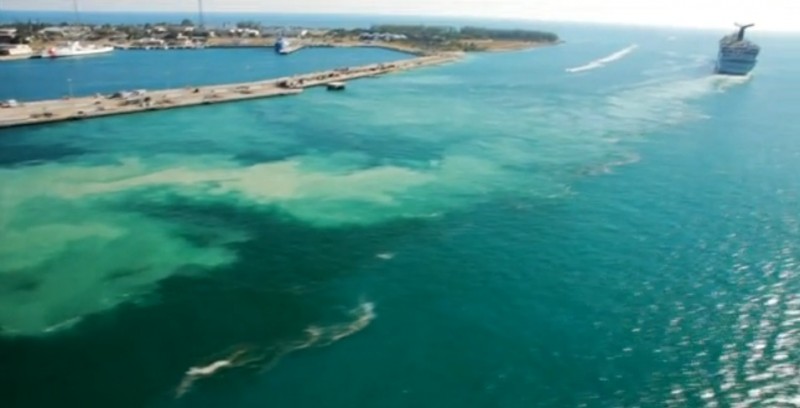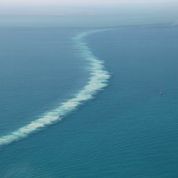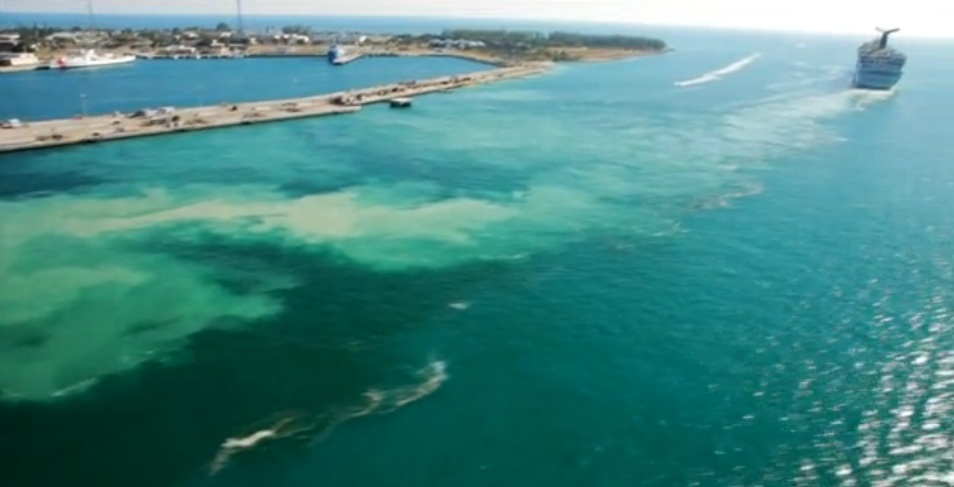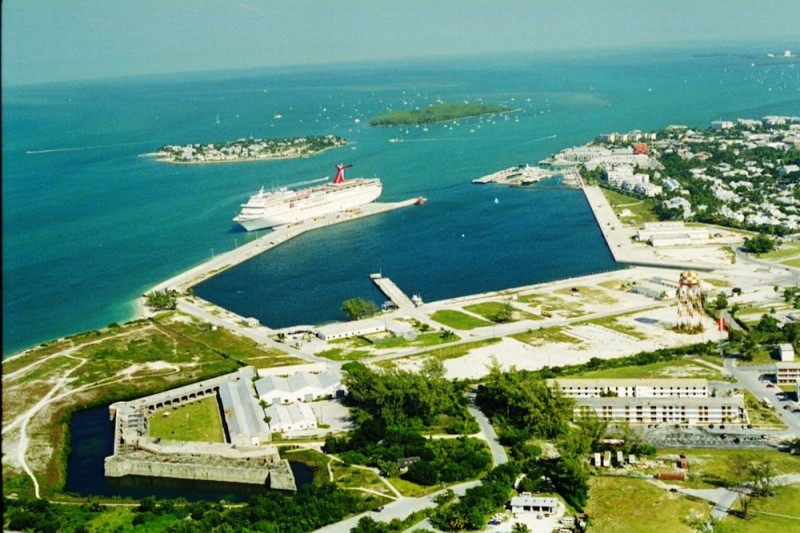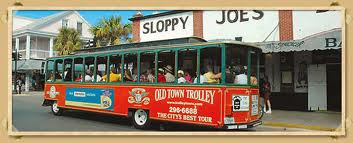Facts and myths about dredging Key West’s channel wider to accommodate bigger cruise ships
Above, cruise ship leaving Key West’s outer mole pier this spring, spliced together by Matt Gardi from Will Benson’s video, “Silver Lining”. Below, cruise ship leaving the outer mole circa 1998. After I published it numerous times, the photo below was featured a few months ago in a front-page article in the Key West Citizen. The photo above, which I have published many times, has not been aired by the Citizen.
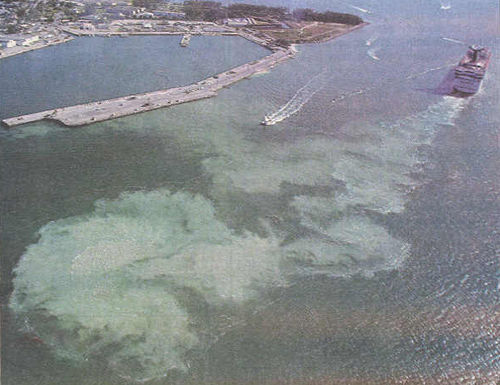 Todd German, of Key West, told me, and repeated it at the anti-channel-dredging meeting at the Key West VFW this past Wednesday night, that when his return flight from New Orleans reached Key West recently, a cruise ship plume stretched from Key West all the way out to the reef. Todd said the other passengers saw talked about what it might be. He did not tell them what he thought it was.
Todd German, of Key West, told me, and repeated it at the anti-channel-dredging meeting at the Key West VFW this past Wednesday night, that when his return flight from New Orleans reached Key West recently, a cruise ship plume stretched from Key West all the way out to the reef. Todd said the other passengers saw talked about what it might be. He did not tell them what he thought it was.
Photo above by Will Benson, sent to me by his brother Jolly, who also sent these photos taken by Will.
A little while after the VFW meeting, received this from Ed Russo, of Key West; Ed is on the Board of Directors of Reef Relief:
Subject: Study info
From: [email protected]
Date: Wed, 4 Sep 2013 21:06:54 -0400
Thanks for posting this.
See you soon.
Ed
———————————————–
To Study, Or Not To Study?
That is the burning question among civically- minded residents of Key West this summer. The upcoming referendum questionof whether or not to proceed with the feasibility study for widening Key West Harbor Channel has the town abuzz and camps divided. The vast range of misinformation, smoke and mirrors, modus operandi and emotion surrounding this topic could fill a book. Do you consider yourself well- informed on all the angles of a “yes” or a “no” vote on October 1st?
Proponents of the study refute that performing this study will in fact lead to a green light on the dredging to widen the shipping lane for a larger, more easily navigable port. In fact, a study will simply afford local leaders an opportunity to make a more informed decision regarding a decision to dredge. A larger, more navigable channel increases Key West’s attractiveness from a business perspective. Indeed, the improvement upon an outdated infrastructure would be a welcome facelift, would it not?
Whereas the feasibility study is “just a study,” as impressed upon local environmental leaders at a recent local meeting, many environmentalists disagree. Research studies on dredging channels are available all over the internet. Rather than a studyyielding science, opponents view the “feasibility study” as a crack in legal protection where a weed can grow, a weed that will inform local policy makers on how to make the dredging happen from a legal standpoint, from a permitting standpoint. This is seen as a slippery slope, an opportunity to further infringe upon an already compromised ecosystem in a federally protected National Marine Sanctuary. Corals on the endangered species list and corals on the edge of endangered designationwould be the immediate victims if dredging were to become a reality.
In the spirit of community and informed discussion regarding this critical referendum question, the Florida Keys Environmental Coalition has organized an open public forum for this very debate on Sunday September 8, 2013 from 6:00- 8:00 p.m. at the Tennessee Williams Fine Arts Center on Stock Island, located at the Florida Keys Community College Key West Campus. Panelists on both sides of the debate will take the stage to answer your questions, moderated by U.S. 1 Radio’s own Ezra Marcus. Scheduled speakers are Jennifer Hulse and Dr. Robin Lockwood on the “just a study” side, and on the “just say no” side, panelists Jolly Benson and Mark Songer. Make an informed decision on voting day. This event is free and open to the public. For more information, visit www.fkec.org.
———————————
I wrote back:
Hi, Ed –
I asked you to include with what you sent your personal sentiments about the referendum, which, you said at the VFW meeting tonight, are: you oppose anything that increases water turbidity. Although I tried a few times to get you to say whether or not you oppose cruise ships, you kept saying what I just wrote that you said.
You said that after hearing me tell John Dolan-Heitlinger of Devon Quirolo’s disagreement with his comment on Reef Relief’s Facebook page about cruise ships no longer dumping their toxic treated wastewater into the ocean. DeeVon said they do dump outside the reef line, inside the Gulf Stream, in route from Port Everglades to Key West. I just sent John that Facebook dialogue between Devon and Peter Anderson, along with the text of DeeVon’s email to me. Here is all is for you to read, in their own words, unchanged by me. I added the Port Everglades photo.
—————————————-
from Reef Relief’s Facebook page [Peter Anderson now is Chairman of the Board of Reef Relief, DeeVon Quirolo was a co-founder of Reef Relief].
Peter Anderson Cruise ships do not dump raw sewage into the sea anymore, Janet. Reef Relief and many others made them change those habits years and years ago.
DeeVon Quirolo Not so. The cruise ship industry made a big deal about agreeing to go to secondary treatment–settling the solids and adding chlorine ON NEW SHIPS ONLY; but they will still dump the highly concentrated liquids overboard and this will at best eventually include only a small fraction of the cruise ships on the high seas. The worst part is that they dump outside the reef tract on their way to Key West from Port Everglades.
DeeVon wrote to me:
The current situation is that cruise ships routinely dump thousands of gallons of partially treated concentrated waste in the ocean outside of the reef on their way to Key West from Port Everglades. They run just outside the reef to avoid the offshore counter current of the Gulfstream, which is why the Area to be Avoided was established by the International Maritime Organization to keep them far enough off critical areas where many large ships ran aground the reef. When I was on the Cruise Ship Task Force for the City, we tried running a sample of cruise ship waste through the sewage treatment plant, but it was so anoxic that it would have shut down the anerobic action of the plant by depleting all the oxygen needed. Plus it was in salt, not fresh water, so that was an additional negative factor that reduced the potential for the biological treatment that is employed at the plant.
All the best, DeeVon
——————————————–
Ed, I think you should read all of that to the audience at this forum you are hosting at the Tennessee Williams Theater, because I seriously doubt the pro-study or the anti-study camps will mention it. I also think you should get this photo blown up
and show it to the audience at your forum, since it is a departing cruise ship from the outer mole pier caught red-handed this spring, by Will Benson, increasing turbidity (gross understatement) in Key West’s channel. I doubt either side will show that photo to the audience, either.
As I said at the meeting tonight, both sides are avoiding talking about cruise ships, without which there would be no referendum or forums or discussion about studying the feasibility of widening the channel.
So far, the Key West Citizen has declined to show the photo to its readers, and so far the Citizen has declined to share DeeVon’s input with its readers. Don’t you find that a bit strange under the circumstances?
Thanks,
Sloan
Ed replied:
Very interesting stuff.
Thanks.
See you tomorrow night. [at the Westin Hotel’s channel-widening referendum forum]
My email to John Dolan-Heitlinger:
From: [email protected]
Subject: cruise ship toxic waste dumping
Date: Wed, 4 Sep 2013 21:08:26 -0400
Evening, John –
Last below is what I told you at the VFW meeting I would send to you. I do not wonder why the pro-cruise ship lobby has not talked about it. I do wonder why the Key West Citizen has not published this information, which I sent several times to Gwen Filosa. It has been published in Key West the Newspaper, in articles I submitted, including an article in this week’s KWTN, entitled “Conversations Between a Psychiatrist and a Mystic“, which you should be able to reach by clicking on that link.
Not for a heartbeat do I believe you would be taking the position you are taking, if you did not work for Ed Swift. Not for a heartbeat do I believe you were not there tonight as a spy for Ed Swift. However, I am glad you were there, because, as I told you at the meeting, you represented and spoke for your boss and the rest of the pro-cruise ship folks, and we got to hear it.
I’m thinking I messed up by not starting my own PAC, like you did, so I could get myself a PAC’s head table seat at channel-widening “study” forums, instead of sitting in the peanut gallery
Sloan
Then followed the same Peter Anderson and Devon Quirolo comments I sent to Ed Russo.
For those who do not know Key West as I do, Ed Swift is a co-owner of Historic Tours of America (HTA), which runs conch trains and trolleys all over Key West, clogging city streets and disturbing residential neighborhoods with loud speakers. Many of HTA’s riders are from cruise ships. HTA also is well paid by the City of Key West to transport cruise ship passengers from the outer mole pier in front of Truman Waterfront
to a terminal near the base of Duval Street, where conch trains and trolleys wait to take them elsewhere.
Cruise ships also dock at the Westin (left ship in photos below), and at Mallory Pier (right ship in photos)
where the daily sunset celebration is held. The city makes good money off of cruise ship passenger disembarkation fees at Mallory Pier, which the city owns. The city makes nothing, as far as I know, off of cruise ship disembarkation fees at the Westin, which is privately owned. The city has to share its disembarkation fees at the outer mole with the Navy.
At the VFW meeting Wednesday night, mayor candidate Margaret Romero said she has studied the city’s books and she is not convinced the city is making any money at all from outer mole cruise ship passenger disembarkation fees. Jolly Benson said, after paying Historic Tours of America, the city makes $2.50 per passenger at the outer mole, but it may well be that after infrastructure maintenance and other costs are factored in, the city makes no money, or even loses money, on outer mole passengers.
Jolly also said, if the referendum approving the study passes, the dredging opponents may not have any further say so in the matter. Jolly said it will be maybe 15 years before the dredging starts, if it ever starts, and the cost will be astronomical, and the city will have to pay 25 percent of it, and there will be no guaranteed city revenue stream to fund a municipal bond, because the revenue stream will depend on cruise ships continuing to call on Key West. Such a bond would have to be approved by the voters, who would not likely approve it. Alternatively, Jolly said, the Feds might waive the city’s contribution to the total cost. Jolly said other cities had spent heaps of money to receive cruise ships, only to see cruises ship companies simply up and sail away into the sunset, leaving those cities with no revenue stream to pay for what they had spent to attract cruise ships.
Margaret Romero said she is against the channel-widening study, but she is not against cruise ships. Her opponent, incumbent Mayor Craig Cates, has said he is for the study. My question is: How can anyone not look at the two photos at the top of this post and not see the problem is cruise ships? And, how can anyone read DeeVon Quirilo’s words and not see the problem is cruise ships?
A major disappointment in the anti-dredging camp’s argument seemed to come from Peggy Butler, formerly of Key West, now of the West Palm Beach area:
Well, they sort of snuck that one in on us here in the Palm Beaches.
—–Original Message—–
From: Dunn, Angela E SAJ <[email protected]>
Sent: Wed, Sep 4, 2013 12:55 pm
Subject: Update: Lake Worth Inlet Feasibility Study (UNCLASSIFIED)
Classification: UNCLASSIFIED
Caveats: NONE
Good afternoon,
Please see attached news release for a short update on the status of the Lake
Worth Inlet Feasibility Study. Thank you.
Angela Dunn
Biologist
Planning & Policy Division, Environmental Branch
US Army Corps of Engineers
P.O.Box 4970
Jacksonville, Florida 32232-0019
904.232.2108 (Office)
904.563.6775 (Blackberry)
Classification: UNCLASSIFIED
Caveats: NONE
Little Lake Worth and Turtle Cove removed as potential locations for mitigation
Posted 9/3/2013
Release no. 13-064
Contact
Amanda Ellison 904-232-1576
Jacksonville, Fla. – The Lake Worth Inlet Feasibility Study proposes to deepen and widen the Federal channel from Lake Worth Inlet to the Port of Palm Beach. The Draft Feasibility Report and Environmental Impact Statement (EIS) has been revised as a result of comments received during the comment review period (including independent external peer review). All comments have been addressed and will be included in the final report and appendices.
Due to significant comments received from stakeholders during the review period, Little Lake Worth and Turtle Cove have been removed as potential locations for seagrass mitigation. The report will be sent as a Draft Final through the U.S. Army Corps of Engineers chain of command for final review over the next 3 months.
The final Feasibility Report and EIS will be released to the public, state and agencies in the November timeframe.
The Corps is currently coordinating with resource agencies for the mitigation plan. Locations for both sea grass and hardbottom mitigation have not been finalized. Concerns over the use of Little Lake Worth, Turtle Cove, or other proposed locations for mitigation have been considered and will be shared with the Florida Department of Environmental Protection and the National Marine Fisheries Service.
Lake Worth Inlet, serving as an entrance channel to the port, is inadequate both in width and depth, negatively impacting future port potential and creating economic inefficiencies with the current fleet of vessels. Based on modern vessel sizes, the port is operating with insufficient channel width and depth.
These deficiencies cause the local harbor pilots and the U.S Coast Guard to place restrictions on vessel transit to ensure safety. In turn, these restrictions lead to light loading, tidal delays, and maneuvering difficulties – resulting in economic inefficiencies that translate into costs to the national economy.
The tentatively selected plan proposes the following: deepen the entrance channel from 35 to 41-feet and widen from 400 to 440-460 feet, plus a southern approach flare; deepen the inner channel from 33 to 39-feet and widen from 300 to 450-feet; deepen the main turning basin from 33 feet to 39 feet and extend the southern boundary of the turning basin an additional150-feet.
Suitable material would be placed in the nearshore, adjacent to the beach, or beneficially used for proposed mitigation; unsuitable material would be taken to the Palm Beach Ocean Dredged Material Disposal Site. Approximately 4.5 acres of seagrass habitat and 4.9 acres of hardbottom habitat would be affected through implementation of the tentatively selected plan. However, 8.25 to 11.25 acres ofseagrass mitigation and 4.9 to 9.8 acres of hardbottom mitigation are under negotiation.
In addition, immediately south of the main turning basin, a warm water outfall from the Florida Power and Light Riviera Plant creates a warm water refugium for manatees during cold periods.
http://www.saj.usace.army.mil/DesktopModules/DigArticle/Print.aspx?PortalId=44&Modul… 9/4/2013
————————————–
I dropped the gist of Peggy’s forward on Jolly Benson at the anti-dredging meeting at the VFW after he told the audience, if the channel-widening study referendum passes on October 2, and the Army Corps of Engineers then does a feasibility study, the Corps will not consider local economic impact but only will consider national economic impact in determining whether or not the channel should be widened to allow more and bigger cruise ships to call on Key West. I said what I had received from a former Key West resident now living in the Palm Beach area indicates the Corps indeed does consider the local economy when it does a feasibility study. In all events, what Peggy sent is a good example of how the Corps thinks and operates elsewhere, and will think and operate in Key West, if the referendum passes.
However it’s sliced, this attempt by Ed Swift & Crew to dredge the channel wider, so more and bigger cruise ships can get into Key West, is about the future of the reef and sea around Key West. I see no way to vote for the channel-widening study, if you want to protect the ocean and the reef near Key West.
